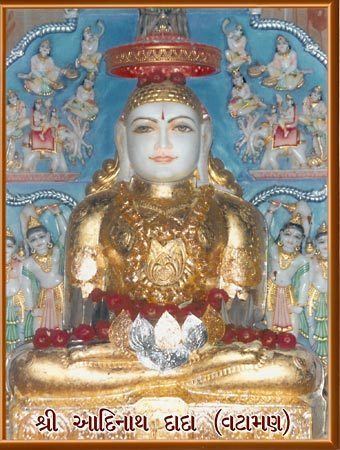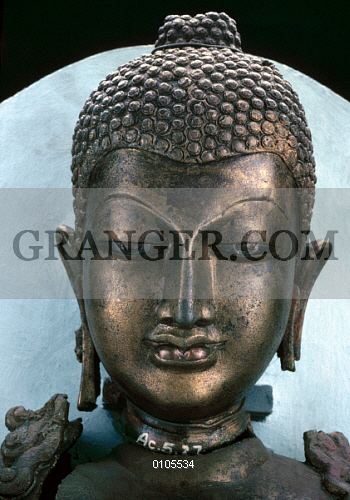Tree Banyan Children Bharata Chakravartin | Height 500 bows (1500 metres) Color Golden Succeeded by Ajitanatha Parents Marudevi, Nabhi | |
 | ||
Other names Adinatha, Adish Jina (first conqueror), Adi Purush (first Perfect Man), Ikshvaku Age 84 lakh purva (592.704 x 10 years) Other name Adinatha, Adish Jina (first conqueror), Adi Purush (first Perfect Man), Ikshvaku Similar | ||
01 stuti shree rishabhanatha ki ft sunita jain
Rishabhanatha also Ṛṣabhadeva, Rishabhadeva, or Ṛṣabha is the first Tirthankara (Teaching God) of the present half cycle of time in Jainism. The word Tīrthankara signifies the founder of a tirtha which means a fordable passage across a sea. The Tirthankara show the 'fordable path' across the sea of interminable births and deaths (saṃsāra). Rishabhanatha is also known as Ādinātha which translates into "First (Adi) Lord (nātha)".
Contents
- 01 stuti shree rishabhanatha ki ft sunita jain
- Focus on lord rishabhdeva s biggest idol at mangi tungi part 1
- Founding of Jainism
- Legends
- Birth
- Kingdom
- Renunciation
- Akshaya Tritiya
- Omniscience
- Moksha
- In literature
- Iconography
- Colossal statues
- Temples
- References

Focus on lord rishabhdeva s biggest idol at mangi tungi part 1
Founding of Jainism

Jain cosmology divides the Worldly Time cycle into two halves (avasarpiṇī and utsarpiṇī) with six aras (spokes) in each half. Twenty-four Tirthankara grace this part of the universe in the fourth ara, known as duşamā-suşamā (read as dukhmā-sukhmā) ara, of both halves. The present half cycle (avasarpiṇī) being a special case, Rishabhanatha, the first tīrthaṅkara was born at the end of the third ara (known as suṣama-duṣamā) itself. This cycle will start reversing at the onset of utsarpinī kāl with the Dukhama-dukhamā ara being the first ara of utsarpinī (half-time cycle of regeneration). According to Jain texts, he was born in the age when there was happiness all around with no work for men to do. Gradually as the cycle moved, and Kalpavriksha (wish-fulfilling trees) disappeared, people rushed to their King for help. Rishabhanatha is then said to have taught the men six main professions. These were: (1) Asi (swordsmanship for protection), (2) Masi (writing skills), (3) Krishi (agriculture), (4) Vidya (knowledge), (5) Vanijya (trade and commerce) and (6) Shilp (crafts). In other words, he is credited with introducing karma-bhumi (the age of action) by teaching these professions to householders to enable them to earn a livelihood. The institution of marriage is said to have come into existence after he married to set an example for other humans to follow. In total, Rishabhanatha is said to have taught seventy-two sciences which include: arithmetic, the plastic and visual arts, the art of lovemaking, singing and dancing. Jain chronology places the date of Rishabhanatha at an almost immeasurable antiquity in the past.

Rishabhanatha is said to be the founder of Jainism in the present half cycle, and is unanimously considered to be so by the Jains. Sarvepalli Radhakrishnan, the first Vice President of India wrote:
There is evidence to show that so far back as the first century B.C. there were people who were worshipping Ṛṣabhadeva, the first tīrthaṅkara. There is no doubt that Jainism prevailed even before Vardhamāna or Pārśvanātha. The Yajurveda mentions the name of three Tīrthaṅkaras - Ṛṣabha, Ajitnātha and Ariṣṭanemi. The Bhāgavata Purāṇa endorses the view that Ṛṣabha was the founder of Jainism.
Legends
Ādi purāṇa, a major Jain text records the life accounts of Rishabhanatha as well as ten previous incarnations.
Rishabhanatha is associated with his Bull emblem, the Nyagrodha tree, Gomukha (bull-faced) Yaksha, and Chakreshvari Yakshi.
Birth

Garbha kalyanaka is the first auspicious event out of five auspicious events (Panch Kalyanaka). It means enlivening of the embryo through the descent of the life (soul) in the mortal body. On the second day of Ashadha (a month of the Hindu calendar) Krishna (dark fortnight), Queen Marudevi is said to have seen sixteen auspicious dreams. King Nabhi explained these dreams to her as a sign of Tirthankara's birth.
Rishabhanatha was born to King Nabhi and Queen Marudevi in Ayodhya, on the ninth day of the dark half of the month of Chaitra-caitra krişna navamĩ. This is the second auspicious event and is known as Janma Kalyanaka.
Kingdom

Rishabhanatha's kingdom was kind and gentle and he is credited with transforming a tribal society into an orderly one. Like all tīrthaṅkara and other legendary figures of Indian history who were great warriors, he too was one with great bodily strength. However, he never needed to show his warrior aspect. Rishabhanātha is known for advocating non-violence, and is said to be one of the greatest initiators of human progress.
Rishabhanatha had two wives, Sunanda and Sumangala. Sumangala was the mother of ninety-nine sons (including Bharata) and one daughter, Brahmi. Sunanda was the mother of Bahubali and Sundari. He taught his daughters Brahmi and Sundari, the Brahmi-lipi (ancient Brahmi script) and the science of numbers (Ank-Vidya) respectively. Rishabhanatha is said to have lived for 84 lakh(840 million) pūrva of which 20 lakh pūrva were spent as a youth (kumāra kāla), and 63 lakh pūrva as the King (rājya kāla).
Renunciation
One day Indra of the first heaven arranged a dance by celestial dancers in the assembly hall of Rishabhanatha. One of the dancers was Nilanjana, whose clock of life had only a few moments left to run. While in the midst of a series of vigorous dance movements, she stopped, and the next instant her form 'dissolved' and she was no more. The sudden fatal death of Nilanjana reminded Rishabhanatha of the world's transitory nature and he developed a desire for renunciation. He gave his kingdom to his hundred sons, of whom Bharata got the city of Vinita (Ayodhya) and Bahubali got the city of Podanapur (Taxila) and became an ascetic on the ninth day of the month of Chaitra Krishna (Hindu calendar). The renunciation is the third of Panch Kalyanaka and is called Diksha Kalyanaka.
Akshaya Tritiya
Akshaya Tritya is considered holy and supremely auspicious by Jains. It is believed that Rishabhanatha took his first ahara (alms) as an ascetic on this day. Rishabhanatha was the first monk of the present half cycle of time (avasarpini). Therefore, people did not know how to offer food (ahara) to Digambara monks. King Shreyansa of Hastinapur town recollected his past life experiences and offered sugarcane juice (ikshu-rasa) to Rishabhanatha. Jains attach great importance to this day as it was only after 6 months that Rishabhanatha was offered food. It is celebrated on the third day of the bright fortnight of the month Vaishaka. He got the name Ikshvaku from the word Ikhsu (sugarcane) and his dynasty became Ikshvaku dynasty.
Omniscience
Rishabhanatha spent a thousand years performing austerities and then attained Kevala Jnana (omniscience) on the eleventh day of Falgun Krishna (Hindu calendar) under a banyan tree. According to Jain texts, Devas (heavenly beings) created a divine preaching hall known as samavasarana. This is the fourth of Panch Kalyanaka and is known as Kevala Jnāna Kalyanaka. According to Jain texts, the following is the number of followers of Tirthankara Rishabhanatha:
As an Omniscient, Tirthankara Rishabhanatha is said to have preached for 1 lakh pūrva less thousand years (kevalakāla).
Moksha
Rishabhanatha is said to have preached Jainism far and wide. He attained Moksha (liberation from the cycle of births and deaths) at Ashtapada (famously known as Mount Kailash) on the fourteenth day of Magha Krishna (Hindu Calendar) at the age of 84 lakh purva (592.704 x 1018 years). His preachings were recorded in fourteen scriptures known as Purvas.
In literature
Iconography
Rishabhanatha is usually depicted in the lotus position or kayotsarga, a standing posture of meditation. The distinguishing features of Rishabhanatha is his long locks of hair which fall on his shoulders, and an image of a bull in sculptures of him. Paintings of him usually depict legendary events of his life. Some of these include his marriage, and Indra performing a ritual known as abhisheka (consecration). He is sometimes shown presenting a bowl to his followers and teaching them the art of pottery, painting a house, or weaving textiles. The visit of his mother Marudevi is also shown extensively in painting.
Colossal statues
Statue of Ahimsa, carved out of a single rock, is a 108 feet (33 m) tall (121 feet (37 m) including pedestal) statue of Rishabhanatha and is 1,840 sq feet in size. It is said to be the world's tallest Jain idol. It is located 4,343 feet (1,324 m) above from sea level, near Mangi-Tungi hills in Baglan taluka. Officials from the Guinness Book of World Records visited Mangi Tungi and awarded the engineer of the 108 ft tall Rishabhdeva statue, C R Patil, the official certificate for the world's tallest Jain idol.
Bawangaja (meaning 52 yards) is a 84 feet (26 m) high statue of Rishabhanatha in Madhya Pradesh, India. This monolithic statue of Adinatha was built in 12th century.
The 58.4 feet (17.8 m) Rishabhanatha Statue at Gopachal Hill, Gwalior Fort, Madhya Pradesh. Thousands of Jain idols including 58.4 foot idol of Rishabhanatha were carved in the Gopachal Hill idol from 1398 A.D. to 1536 A.D. by rulers of Tomar dynasty rulers — Viramdev, Dungar Singh and Kirti Singh.
